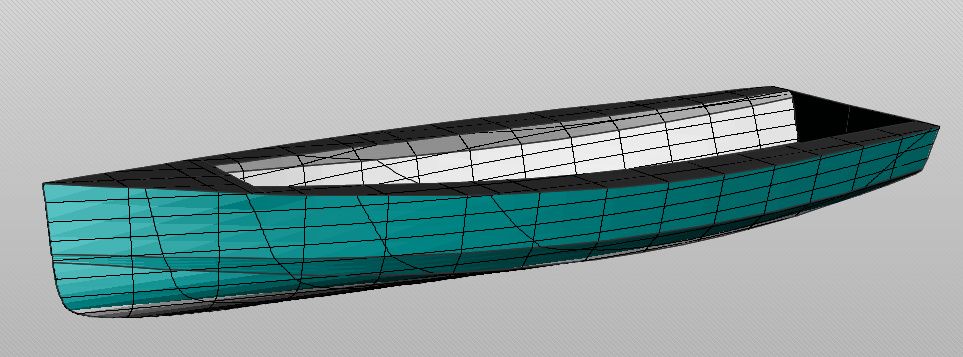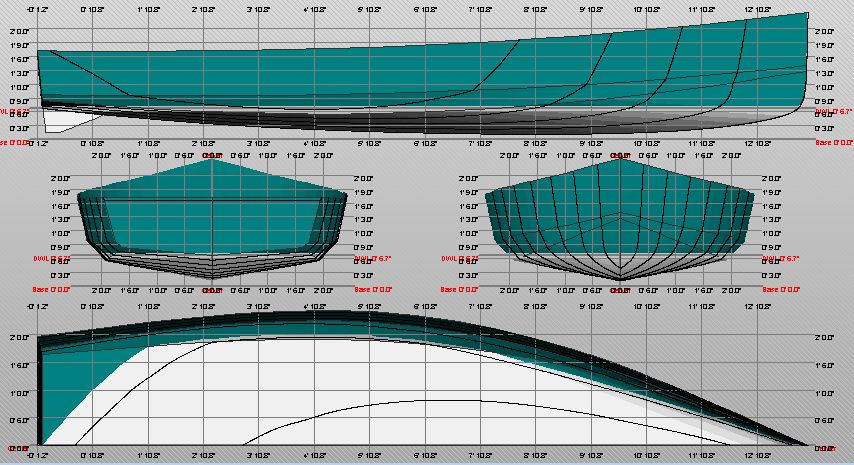The $600 sailboat
by John MacBeath Watkins
My friend Pete Chopras came up with the idea of having a class of boats that would be limited by a box rule and a limit of $600 for materials. I've been thinking about building one for more than a year, but between moving the business and my residence, and not having a space to build in, I've yet to get past the design phase.
Two boats that strictly meet the rules have been built, and are on the dinghy dock at Leshi, on Lake Washington. A third got built at the Port Townsend Wooden Boat Festival, but it uses items (such as the mast and rudder) left over from other boats the builder, Richard Woods, has owned and does not strictly comply with the $600 limit. Pete built the hull of his own boat, but life has interfered with completing it.
I began thinking about this in terms of a boat that would be fast, challenging to sail, and forgiving if you screwed up.
But I've run into a problem. If I'm going to spend the time and effort to build the boat, it needs to be a pleasant daysailer. The requirements for such a boat are at odds with going as fast as possible.
The basic philosophy with racing dinghies is that the boat will be fastest when sailed flat, therefore the hull needs almost no initial stability. In fact, a stable hull will have more drag than an unstable hull, so stability is a negative. The formula for stability is the weight of the crew and their distance from the center line of the hull. Richard's boat, built to his Zest design, is exactly that sort of boat, narrow and with hiking wings, and will no doubt be the fastest of those built for the class, and not just because he's a better racing sailor than the rest of us..
But I want a boat with enough stability that I don't have to work my butt off when daysailing.
So, I've decided that if I build for this class, I'll build a boat that is pleasant to own and sail, and not worry too much about speed.
This is what I came up with:
And the lines drawings:
The box rule is 14 ft. by 5 ft. The boat is supposed to be able to carry as much as 500 lb. of crew and cargo.
I do have a little problem with this. 500 lb. indicates a crew of three, and that's a bit intimate for a 14 ft. boat. I could build a 15.5 ft. boat with the same scarfed pieces of plywood, waste less ply and have more room for crew. But if I build it that big, it won't have a class to race in.
Two of the boats are built with Ironply, a product that is a high-quality underlayment with the right glue to tolerate marine use. I might use that, though if I can get a good enough deal on marine plywood, I'd go with that.
The next problem is getting cheap enough sails. Practice sails for a Club 420 are available fairly cheap, and if I use a centerboard, I can move the center of lateral resistance aft by pulling the board part way up, in case I want to daysail with just the main up. Again, a daggerboard would be faster, with an aperture that would provide less induced drag, but I want a practical daysailer.
The boat is a smaller version of something I drew up for illustrative purposes for my sister, who was working on saving the sail training program for Vashon's Quartermaster Yacht Club, so I've been thinking of it as the Vashon skiff.
It's designed for stitch and glue construction, and the panels develop very little stress, so it should go together fairly easily. The decks are designed so that they all develop as well. The double hull construction will make the boat heavier than a single hull with buoyancy bags, but should I capsize in cold water, I doubt very much I'll feel like spending a lot of time bailing.
With a crew of two, the boat should float with a waterline beam of 4 feet, which I believe is a little more than the waterline beam of a 420. So, the boat will probably be a little slower than a 420, at least in light air, but not much slower. The sharp entry and V'ed forward sections should make it a dry boat, though flatter sections might get it planing sooner.
For the rules for this class, go to post 967 here: http://www.boatdesign.net/forums/sailboats/new-low-cost-hardware-store-racing-class-input-proposed-rules-42343-65.html
My friend Pete Chopras came up with the idea of having a class of boats that would be limited by a box rule and a limit of $600 for materials. I've been thinking about building one for more than a year, but between moving the business and my residence, and not having a space to build in, I've yet to get past the design phase.
Two boats that strictly meet the rules have been built, and are on the dinghy dock at Leshi, on Lake Washington. A third got built at the Port Townsend Wooden Boat Festival, but it uses items (such as the mast and rudder) left over from other boats the builder, Richard Woods, has owned and does not strictly comply with the $600 limit. Pete built the hull of his own boat, but life has interfered with completing it.
I began thinking about this in terms of a boat that would be fast, challenging to sail, and forgiving if you screwed up.
But I've run into a problem. If I'm going to spend the time and effort to build the boat, it needs to be a pleasant daysailer. The requirements for such a boat are at odds with going as fast as possible.
The basic philosophy with racing dinghies is that the boat will be fastest when sailed flat, therefore the hull needs almost no initial stability. In fact, a stable hull will have more drag than an unstable hull, so stability is a negative. The formula for stability is the weight of the crew and their distance from the center line of the hull. Richard's boat, built to his Zest design, is exactly that sort of boat, narrow and with hiking wings, and will no doubt be the fastest of those built for the class, and not just because he's a better racing sailor than the rest of us..
But I want a boat with enough stability that I don't have to work my butt off when daysailing.
So, I've decided that if I build for this class, I'll build a boat that is pleasant to own and sail, and not worry too much about speed.
This is what I came up with:
And the lines drawings:
The box rule is 14 ft. by 5 ft. The boat is supposed to be able to carry as much as 500 lb. of crew and cargo.
I do have a little problem with this. 500 lb. indicates a crew of three, and that's a bit intimate for a 14 ft. boat. I could build a 15.5 ft. boat with the same scarfed pieces of plywood, waste less ply and have more room for crew. But if I build it that big, it won't have a class to race in.
Two of the boats are built with Ironply, a product that is a high-quality underlayment with the right glue to tolerate marine use. I might use that, though if I can get a good enough deal on marine plywood, I'd go with that.
The next problem is getting cheap enough sails. Practice sails for a Club 420 are available fairly cheap, and if I use a centerboard, I can move the center of lateral resistance aft by pulling the board part way up, in case I want to daysail with just the main up. Again, a daggerboard would be faster, with an aperture that would provide less induced drag, but I want a practical daysailer.
The boat is a smaller version of something I drew up for illustrative purposes for my sister, who was working on saving the sail training program for Vashon's Quartermaster Yacht Club, so I've been thinking of it as the Vashon skiff.
It's designed for stitch and glue construction, and the panels develop very little stress, so it should go together fairly easily. The decks are designed so that they all develop as well. The double hull construction will make the boat heavier than a single hull with buoyancy bags, but should I capsize in cold water, I doubt very much I'll feel like spending a lot of time bailing.
With a crew of two, the boat should float with a waterline beam of 4 feet, which I believe is a little more than the waterline beam of a 420. So, the boat will probably be a little slower than a 420, at least in light air, but not much slower. The sharp entry and V'ed forward sections should make it a dry boat, though flatter sections might get it planing sooner.
For the rules for this class, go to post 967 here: http://www.boatdesign.net/forums/sailboats/new-low-cost-hardware-store-racing-class-input-proposed-rules-42343-65.html


Sounds very interesting indeed. How about a link to the complete set of rules?
ReplyDeleteHere you go, post 967. http://www.boatdesign.net/forums/sailboats/new-low-cost-hardware-store-racing-class-input-proposed-rules-42343-65.html
ReplyDelete